The world has lost 97% of its tiger population in a little over a century. Three tiger subspecies, the Bali, Javan and Caspian tigers, became extinct in the 1980s. An accurate count of how many tigers are left in the world is uncertain but, one thing’s for sure, the numbers are alarmingly low.
Contents
How Many Tigers Are Left In The World
Why Are Tigers Endangered?
Unfortunately, tigers have been hunted by man for centuries. Killing a tiger was once considered a status symbol and the spoils were used to adorn the walls and floors of the upper classes. And the main prize is the use of tiger parts in traditional Chinese medicine.
In India, the trophy-obsessed British Raj hunted tigers as a pastime.
This pursuit contributed significantly to the rapid reduction in the world’s tiger population.
The British hunting culture along with the destruction of habitat has reduced the Bengal tiger population from around 40,000 tigers in 1947 (when India gained independence) to less than 3200 tigers.
According to WWF, the tiger population in the wild has recovered and there are now 5574 tigers are left in the world in the wild.
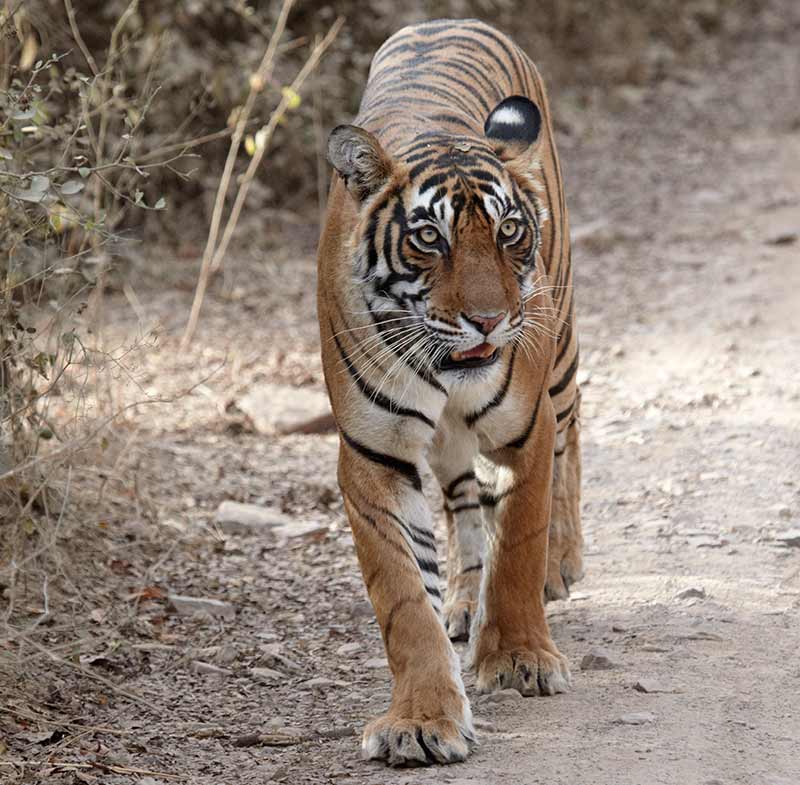
Where do tigers live now?
About 50% of wild Bengal tigers in the world roam the national parks of India. The Bengal tiger is a subspecies native to the Indian subcontinent.
Wild tigers are becoming increasingly difficult to spot in India, although, if you’re lucky, there’s a chance of seeing one while on a tiger safari in Ranthambore National Park, Rajasthan.
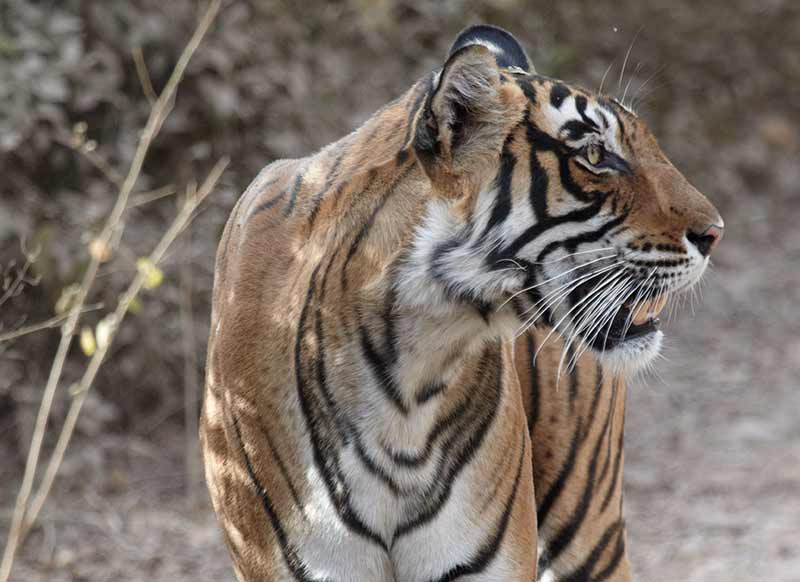
Ranthambore National Park tiger safari
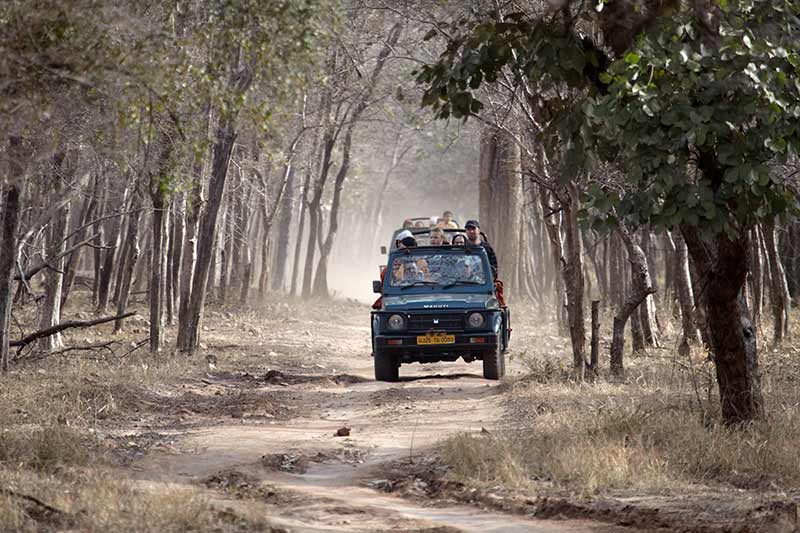
It has been hours since we left our camp and it feels like we have been driving around Ranthambore National Park forever.
Our guide, Nafiz, is trying his best to show us a tiger but so far the dry deciduous forest has revealed sambar, nilgai and chital deer along with langur monkeys hanging around under a tree.
I swear one of those monkeys pulled a face at me!
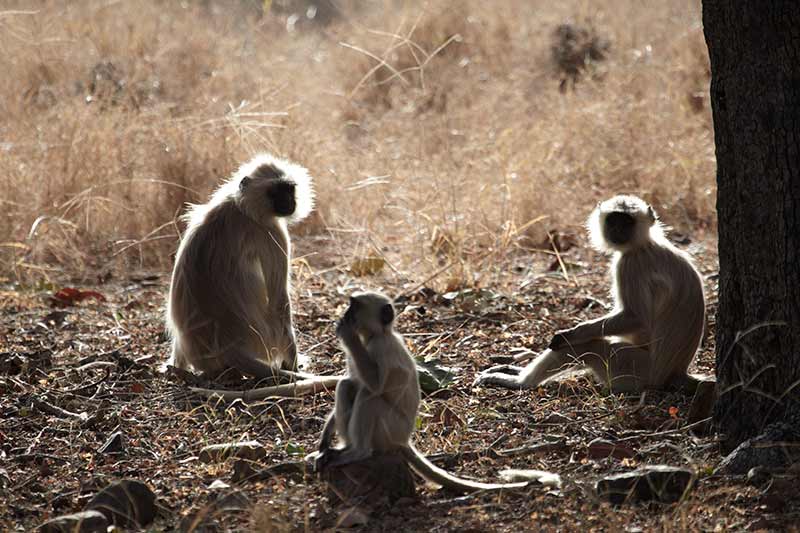
We pass some crocodiles lying on a riverbank and spot a cheeky mongoose spying on us between blades of straw-coloured grass.
The mongoose was well camouflaged and would have been difficult to spot were it not for the sharp eyesight of our guide.
While driving around the forest, we pass other jeeps and huge canters (trucks) packed with about 20 people.
We’re all looking for the same thing.
We’ve come to Ranthambore National Park in Rajasthan in search of tigers. But our search has so far been unfruitful.
Nafiz keeps reassuring us that there’s at least one tiger lurking somewhere in the woods. He points to a spot beneath the bulwarks of the 10th-century Ranthambore Fort.
While I’m happy that our guide is motivated to find us a tiger, I’ve come prepared to be disappointed.
Due to the dwindling tiger population, seeing a tiger in the wild is becoming increasingly challenging.
Tracking tigers requires a great deal of patience.
A tiger safari is nothing like an African wildlife safari.
In most African safari destinations, big cats are usually much easier to spot.
In Africa, it would not be unusual to see lions, cheetahs and leopards within a short drive from your safari camp.
Spotting tigers is even harder than spotting gorillas as a gorilla trek in Uganda or Rwanda offer a high chance of getting close to them.
Is Chinese Medicine a threat to tigers?
Chinese culture has mythologized the powers of the tiger and tiger parts have been used in traditional Chinese medicine for over 1000 years.
Almost every part of the tiger is used for a medicinal cure.
Tiger claws are a sedative for insomnia while teeth are used to treat fever.
Tiger bone is believed to be an anti-inflammatory and used to treat rheumatism and arthritis.
The unfortunate part about this is most of these ailments can be treated with over-the-counter medications, such as aspirin, or natural remedies.
Even so, the demand for tiger parts for use in traditional medicine continues to fuel tiger poaching.

Greedy traders entice villagers to kill tigers for a small amount of money (often as little as $15).
The middlemen make substantial profits from the trade in tiger parts, which is illegal according to resolutions adopted by CITES (Convention on International Trade in Endangered Species of Wild Fauna and Flora).
CITES has 160 country members.
Organised criminal networks run this illegal trade in tiger parts and China is the main market for these illegal activities, even though the country has been a member of CITES since 1981.
Project Tiger, which began in 1973, created tiger reserves in national parks across India. Fortunately, the Indian government is doing something to save the Bengal tiger from extinction.
Where are tigers found?
There are tiger sightings daily in Ranthambore but due to the number of visitors, you can count yourself lucky to get a good eyeful of a tiger.
We pass several jeeps filled with unhappy customers.
There are long faces and lots of people come close enough to a tiger to hear a roar but are not in the right spot to actually see one.
Ranthambore National Park is a national park in eastern Rajasthan.
It was the hunting reserve of the Maharajahs of Jaipur.
The Royals threw hunting parties for other royalty (Princess Elizabeth and the Duke of Edinburgh visited in 1949).
In 1957, the national park was turned into a wildlife sanctuary and it became part of Project Tiger in 1973.
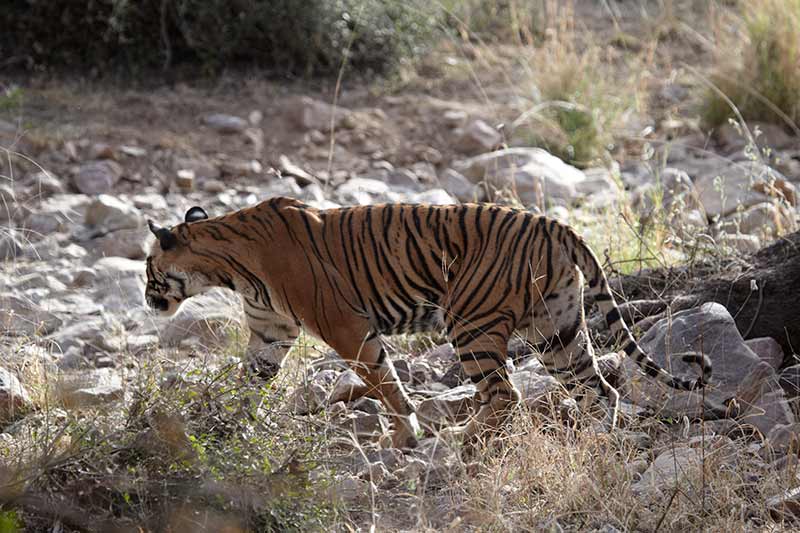
Finding tigers is not simply dependent on luck. Actually, the tigers in Ranthambore National Park are monitored through cameras fastened to tree branches.
National park authorities allocate zones to the 20-seat open-top canters and six-seat jeeps each day.
Nafiz believes luck is on our side as the previous evening, a young village man had been killed by one of the tigers in this section of the national park while collecting firewood (an activity he shouldn’t have been doing).
We stop to watch a troop of langurs swinging on the tree branches.
Suddenly, there’s a flash of yellow. All eyes swing towards a dry patch of deciduous forest. Nafiz jabbers instructions to our driver and we’re soon careening towards the park’s main road.
On the main road, cars, motorbikes and safari jeeps are piled up like a parking lot.
The babble of voices from the excited crowd sounds like a crowded fish market.
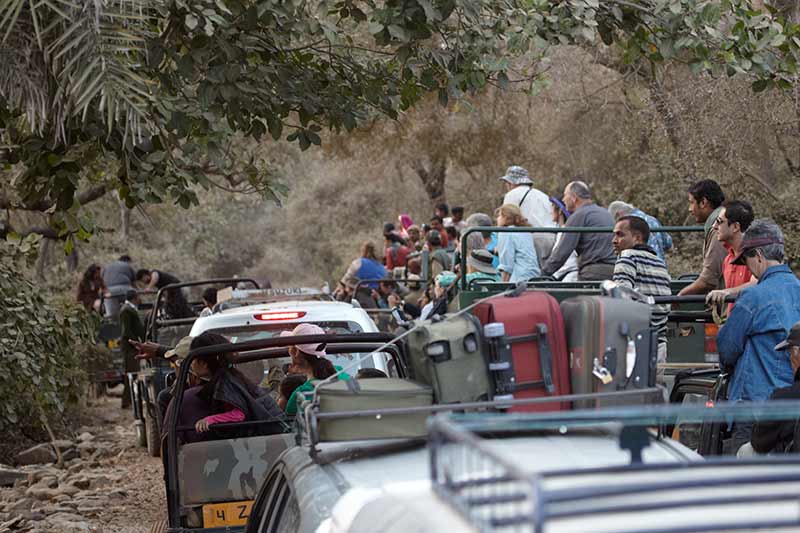
I can’t believe my eyes when I see a tiger walking towards me.
When it keeps on walking towards us, the driver tries to back the jeep up but we’re jammed in by other vehicles.
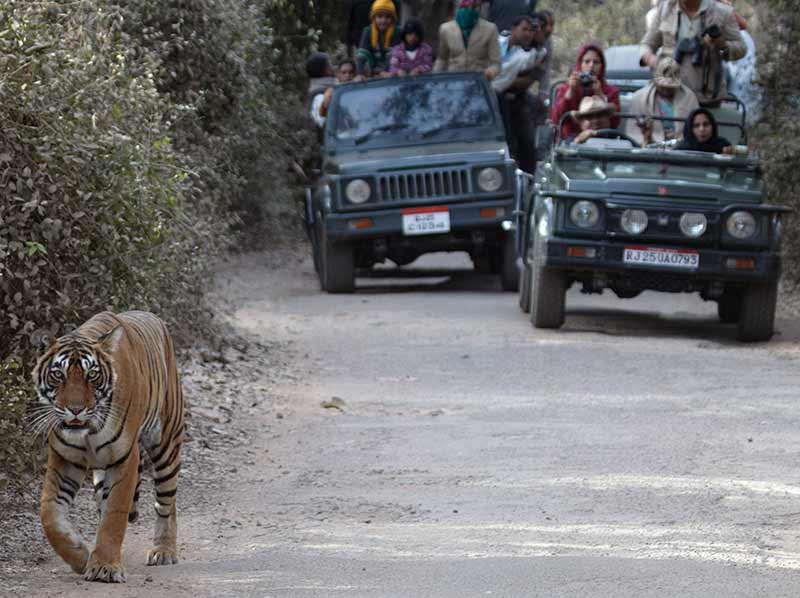
The tiger (we’ve now identified it’s a female) decides to veer off the main road and disappears behind a bush.
I hold my breath hoping she will show herself again.
Then she reappears in a clearing next to a large tree.
She heads over to the tree trunk, lifts a leg and sprays her scent on the tree trunk.
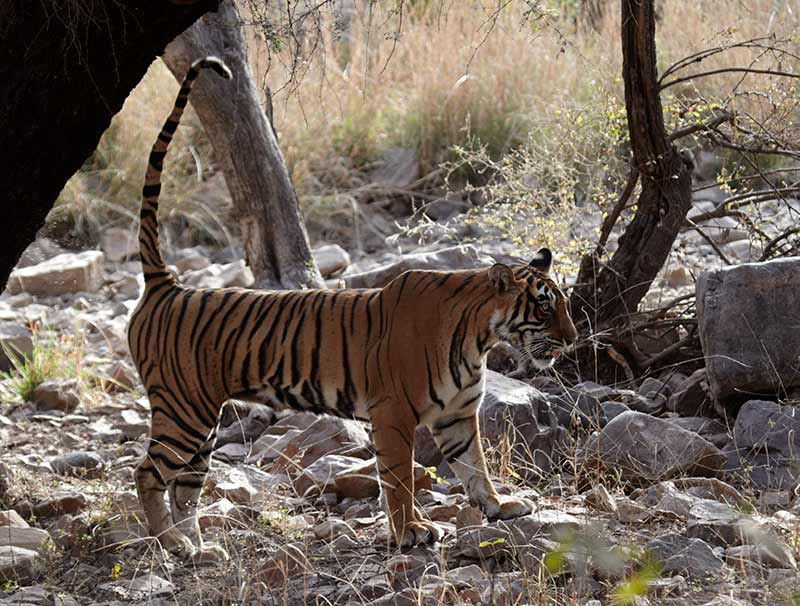
I’m beyond excited by this close-up sighting of a wild tiger and would have been extremely satisfied with this experience.
Then someone shouts: “Look, there’s another one.”
A huge male tiger emerges from behind a dry clump of grass and strides forcefully towards the tigress.
His huge belly tells me this could be the tiger that ate the villager.
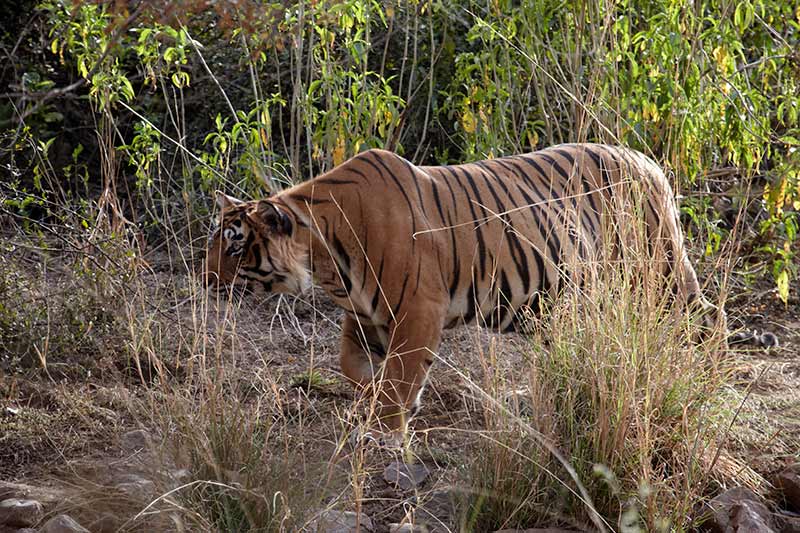
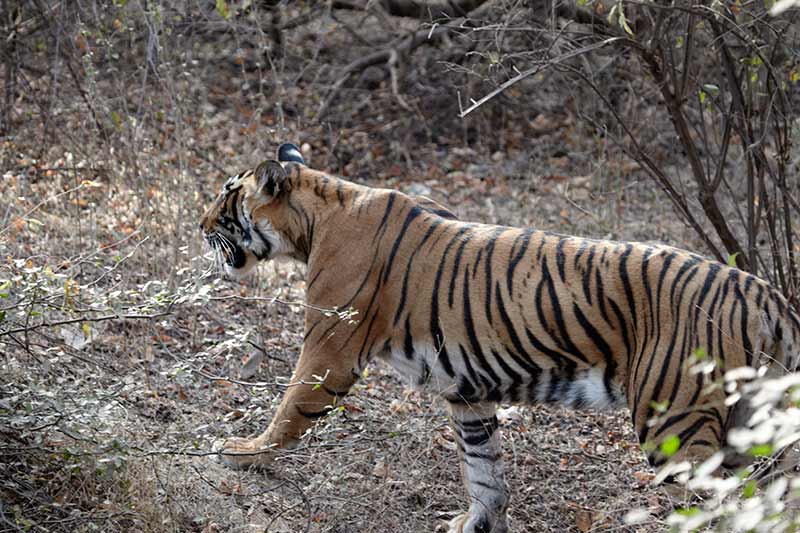
There’s an earth-shaking roar as the male tiger and approaches the female tiger.
When the male is close enough, she whacks the male on the face with her paw. It seems she’s not interested in his amorous advances.
For a split second, I’m sure there’s going to be a fight, then he turns away and runs back into the bushes.
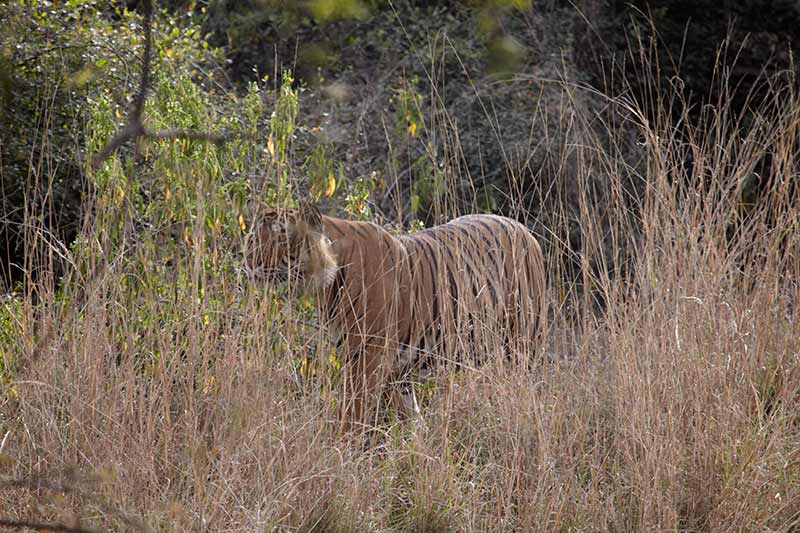
This has been an amazing tiger sighting and a wildlife experience I will never forget.
Live like a maharajah

I’m staying at luxury safari camp Aman-i-Khas.
Even though my tent has a cotton canvas canopy and billowing cotton screens, you can hardly call it a tent.
It’s as luxurious as any luxury hotel in India.
It’s huge and richly decked out with custom-made teak furniture and lavish soft furnishings such as rugs and bronze pots.
There are separate areas for sleeping, bathing and dressing. There’s a large day bed and a very comfortable king-sized bed.
It has everything you’d expect in a resort room, including a writing desk, table and chairs, vanity unit and a wardrobe.
The bathroom has a shower and a sunken bathtub. And there’s hot water.

Meals are served in the camp.
While you mostly dine in the main dining tent, other options are dining next to the swimming pool or in a romantic forest clearing.
The chef uses fresh vegetables from the camp’s garden.
An inspection of the garden reveals cabbages, red chillies, broccoli and other veggies.
Best of all, I have a butler.
Mukesh is always ready and willing to tend to any request.
He brings me coffee and cookies at dawn, makes sure my clothes are laundered and my safari jeep is stocked with everything I need to live like a queen.
He thinks of everything down to a blanket to keep me warm in the early morning, plenty of drinking water, sunscreen and snacks.
At night, around the campfire, there’s a wonderful mood and I’m on a high as I exchange tiger stories with other guests.
One family was unlucky.
They heard the tigers but only managed to catch a glimpse from a distance.
Another family followed a different tiger for one kilometre and had the tiger to themselves, with only one other vehicle in sight.
To sum up the experience, tracking tigers offers the thrill of the hunt with no walkie talkies.
You’re relying on luck and the skill of your guide to find and follow the tiger.
If you’re fortunate enough to get close to one, it’s a very special experience and enormously satisfying.
How to see tigers in India
Singapore Airlines flies to Delhi, where you can connect to Jaipur on Jet Airways.
Ranthambore is about 3.5 hours by road from Jaipur. While in Rajasthan, it’s worth visiting Jodhpur (also known as the Blue City) and the lovely Udaipur (the lake city).
Aman-i-Khas is a boutique luxury camp at the edge of Ranthambore National Park (Phone +94 777 743500).
Visit Ranthambore National Park between October and June.
While in India, you might also want to visit these landmarks in India.
Tiger tip
As guides are randomly allocated to guests by national park authorities, its worth booking through a tour company that has the right connections.
How many tigers are left in the world?
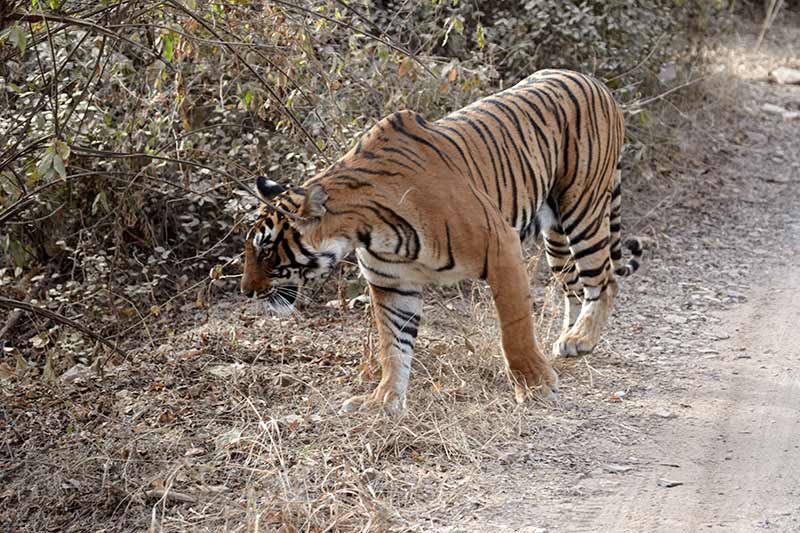
1- There are an estimated 3890 tigers left in the wild.
2- According to WWF there are more tigers (between 5000 and 7000 tigers) living in captivity in the USA than in the wild.
3- In the USA, there are no federal laws regulating the possession of exotic animals. You can buy a tiger online (a five-month-old tiger cub costs around US $14,000). In Australia, exotic animals (such as monkeys, lions and tigers) can’t be kept as pets by private owners.
5- India has the largest population of wild tigers.
Save the tiger
You can help save the tiger by adopting a tiger for as little as $55 through WWF


Plan Your Trip

Rent A Car – Find the best car rental rates at Discover Cars. They compare car hire companies to provide you with the best deal right now.

Find A Hotel – If you’re curious about this article and are looking for somewhere to stay, take a look at these amazing hotels.


